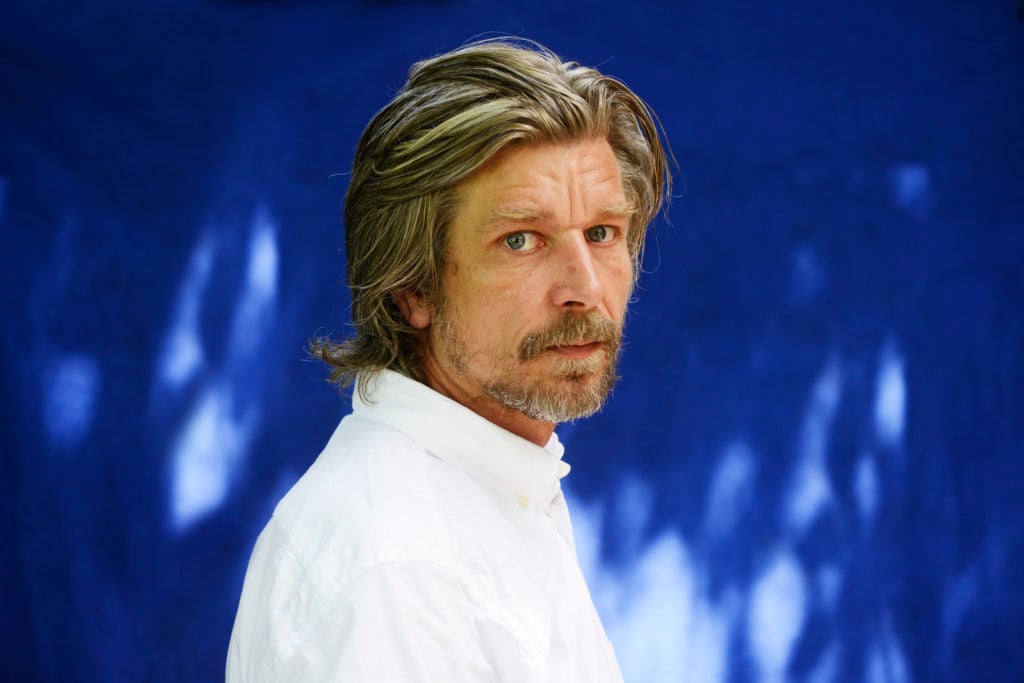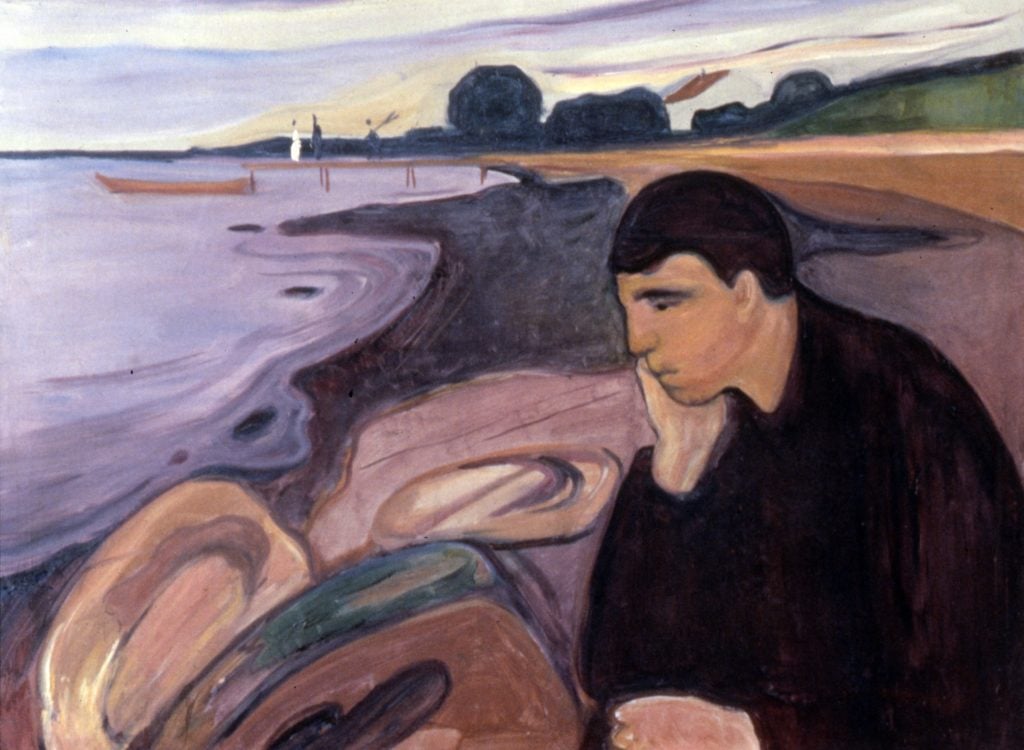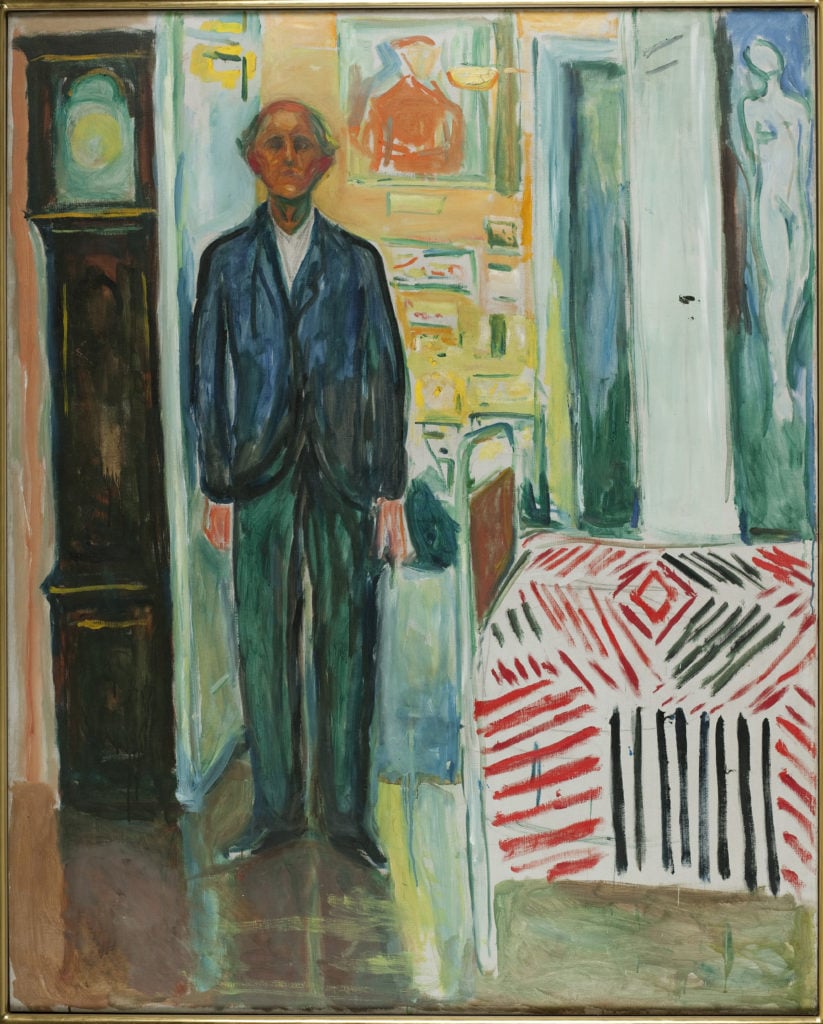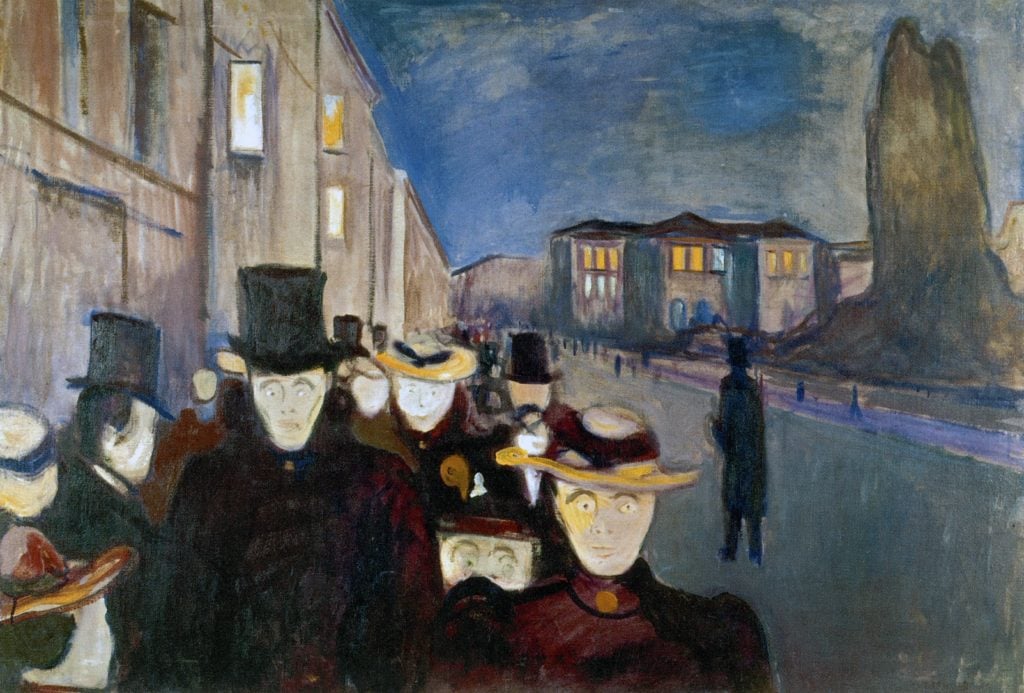People
Novelist Karl Ove Knausgaard Spent Too Much Money on a Munch Artwork at Auction and Now He’s Filled With Shame: A Q&A
We spoke with the famed author about his new book on Munch, and how he does—and doesn't—identify with the Modernist painter.

We spoke with the famed author about his new book on Munch, and how he does—and doesn't—identify with the Modernist painter.

Pac Pobric

There is an episode in the Norwegian novelist Karl Ove Knausgaard’s newest book, So Much Longing in So Little Space—a reflection on the life of his countryman, artist Edvard Munch—that so perfectly captures his manner of writing and way of experiencing the world that I wish I could quote it in full.
It happens toward the end of the book, long after we’ve learned of Knausgaard’s almost magical attraction to the modernist painter. By this point, Knausgaard has discovered that a print by the artist is up for sale through an online auction house, and he cannot help but indulge the idea that he could have a work by Munch—his very own!—to admire whenever he likes. So he puts down a bid and a few minutes later, the price jumps up.
“So some bastard was out there who also wanted the picture.”
He places a new bid, but no, the price rises again. “I waited a little while to give the bastard hope, let him or her sit there and fill up with joy at having succeeded at having acquired the picture,” he writes, “and then, when there were only a few minutes left, I placed a new bid. Ha!”
Yet again, the price edges upward, and Knausgaard, already having committed more money than he originally intended, refuses to let it go. By this point, it was “no longer about money, it was about winning, crushing the other bidder, whoever it might be.” With a final bid, he wins the work: “The picture was mine.”
In the days that follow, he is filled with shame. Oh, what he could have done with all that money! A vacation his children would never have forgotten! A renovation of his home so each boy and girl could have his or her own bedroom! Even a nice juice press for the family to enjoy all the apples and pears in his garden! “Instead,” he writes, “they got a little picture on a wall.”
This is classic Knausgaard, full of all the themes that made his breakthrough series of six autobiographical novels, My Struggle, so richly revealing and strangely enjoyable. There is pettiness, impulsiveness, shame at his inability to control his behavior—and all of this is packed into just a few short pages in a book about Munch that only Knausgaard could have written.
On the occasion of the new publication, artnet News spoke with the famed author about the bidding episode, his tentative forays into painting, and why Munch’s paintings are like living people.

Edvard Munch, Melancholy (1894–96). Photo: Universal History Archive/UIG via Getty Images.
Let’s talk about the process of researching and writing the Munch book. How did you begin?
When I was 40, one of the presents I got was the collected—what do you call them? The books where all the artworks are collected.
A catalogue raisonné?
Yes, exactly. I got the complete paintings of Munch. I start to look at them quite intensely for quite a long time. Then for some reason, the Munch Museum asked me if I could make a public talk. Then they asked me to create a Munch exhibition in Oslo.
So then I thought: okay, I will also write a book about Munch, a very unpretentious book. When I sat down to do that, I didn’t know what that book would be. So I just started writing about a painting and then about his life, and I was reading some biographies and documents he had written. Basically, most of it was looking at his paintings.
I also decided I wouldn’t write a biography, and I wouldn’t write only about Munch; I would write about who Munch was now for me, and for other people. So I also included artists I really like and respect, and tried to just look at their relationship with Munch.
There have already been so many exhibitions about Munch and so many books and articles. Is it difficult, after spending so much time writing about yourself, to shift to writing about someone who occupies such a vivid place in the popular imagination?
No. Writing about yourself, it’s like when you have a heavy rucksack on your back, and you’re walking up a hill. Writing about something else is like taking off the rucksack and starting to walk downhill. It’s much, much easier. The one thing I had to do was to write without caring about what I was actually writing. I tried just to accept whatever came. So much is known. So many theories, so many ways of looking at Munch and art in general are out there, so if you stop to think about what you can and cannot write, it’s a dead end. It’s a hundred dead ends. And in my writing, I try very much to be free and not to care. So this is Munch for me now, in 2019, and that’s it.
I tried to find out what it is to write, what it is to paint, what it is to create, more or less. I tried to use my own experience, because I think there are so many similarities between writing and painting.
Let’s talk about that. At the very end of the book, you write: “In themselves pictures are beyond words, beyond concepts, beyond thought, they invoke the presence of the world on the world’s terms.” You’re stressing that it’s very difficult for language to hold onto something. Did you begin the book with that thought, or is it something you discovered through the process of writing?
That’s kind of a constant. I think that’s why I have been writing a lot about art these last years. Because for me, the fascinating thing with visual art—paintings, photography—is that it’s so enigmatic and so mysterious. It’s so rich and fills me with so much, just in looking. Whenever I write about art, it’s a reduction of it. It can also become something else with the experience of writing. That’s certainly an obvious thing.
But that’s why people paint, and that’s why I’m so envious of painters, because they don’t have to go through concepts. They don’t have to go through thoughts or words or anything like a detour. In visual art, it’s completely direct. It grips you at once. At least, that’s what I like.

Edvard Munch, Self-Portrait, Between the Clock and the Bed (1940–42) Photo: Fine Art Images/Heritage Images/Getty Images.
So painters have more direct access to their medium. But what about some of the similarities between writing and painting?
That’s hard. You have to go through the process of writing, much more than the form. I don’t know if this counts for every writer, but what I experience is that when I start to write, it’s like I’m disappearing. I’m selfless, in a way. The first person I heard describe that was Ian McEwan. He described that as the most happy moment in writing, the few moments where he was selfless. You don’t know where you are, who you are. You’re just in that process, and I think that’s common to all creative processes. That’s the best case.
I have been painting just for fun, just for myself. I’m completely amateurish, but it’s obsessive, I can do it for 20 hours nonstop. It looks ridiculous, but it was so completely—what do you say?—hypnotic. You’re completely mesmerized by it. I think that’s probably more about painting. But I don’t know really. This question demands a book.
What about your direct experience of Munch’s work specifically? How would you describe that experience?
If you think about Munch, he’s very literary. His most famous paintings from the 1890s, there’s almost nothing going on in them. It’s very easily read. It’s very flat. It’s a symbol, and when you get the symbol, that’s it. There are no painterly qualities in it. It’s just, bam—that’s what it is. It’s jealousy. It’s anxiety. It’s melancholy.
But then when you go and see them, they come alive, and they grip you. There’s a power in them. Despite all of those wrong things they are doing, they almost have the presence of a person. That’s the power of Munch. It goes much beyond what you can know about that person, but that person stands in front of you. You have the feeling of someone.
Yes, you write in the book that his paintings are like people.
Yes, that’s it.
So to what degree do you identify with him? Because at certain points in the book, the association is quite close. You write about how, when you’re selecting pictures for the exhibition in Oslo, you’re speaking with scholars of his work who don’t like the examples you’ve chosen. And you write about wondering whether you’ve picked the right works and you say: “Was I creating an image of him which didn’t actually fit him, but rather me—and if so, with what right?”
I think that’s almost unavoidable when you’re making a selection of works by an artist or trying to reflect upon art. All you can do is use yourself. There is no other way—you don’t have any other means than yourself. With Munch’s art, it’s very much about emotions, and you release them into the art. It’s your emotions. It’s your loneliness.
I get asked a lot if I identify with him. And I don’t know. It would be like a writer in America saying, “I’m like Hemingway.” It’s a stupid thing to do, you know. That’s an embarrassing thing, too. I haven’t done it. It’s just a way of trying to understand your own soul. That’s what I have been doing. There’s nothing in common other than that. I just have to say that, so people don’t think I’m completely crazy.

Edvard Munch, Evening in Karl Johan Street (1892). Photo: Photo12/UIG from Getty Images.
Well, there are some things in common though, aren’t there? You talk about reading the Rolf Stenersen biography of Munch, where Stenersen says Munch talked a lot—he would go on and on and use speech as a kind of self-protective mechanism. There’s a lot of that, I think, in the My Struggle books. You reveal quite a bit of yourself through your writing, but it’s also a shield. Munch seems to have done the same.
There’s also an incredibly good biography of Munch by Sue Prideaux and she writes about his upbringing and the loss of his sister and mother. Those are well-known facts of his life, and they make him very different from me.
What we have in common is a desire. He had it for painting, I have it for writing. And I’m hiding in my writing, very much. And I am absolutely sure he was hiding in his painting. That’s part of the extremely monotonous life he had during his last years.
But with the shame I felt when selecting those paintings [for the Oslo exhibition]: they were bad—really, really bad. And there was so much at stake. It’s a big exhibition, and it’s a very high-profile thing. That shame is very powerful. Can you imagine how shameful it must have been for Munch, who actually painted those paintings, and had people laughing at them?
That’s when you understand what it really is to paint. It’s you. It’s your soul. It’s all your own, and everything is there. I think the more you dare, the better the art. And the less you dare, or the more you hide—it’s not necessarily lesser art; but it doesn’t get that grip on you. Or maybe that’s just more about writing than painting… I don’t know.
That’s interesting, because the part of the book where you discuss buying the Munch print is filled with that feeling of shame, and there’s a lot of humor there as well.
Yes.
I really enjoyed that part.
I don’t know why I wrote it. That is what happened, and I think every time I go into something… I don’t really know what to say about that. But I think it was funny.
I imagine you still have this print. Am I correct?
Yes, of course, yes. I do.
Where do you have it? Do you have it in a prominent place in your home, or a more private place?
No, it’s just among the other pictures. Nothing specific about it.
What does it do for you to look at it? What effect does this print have on you?
I don’t know what to say, but I love it. Many works of art wear out. You see them 200 times, and you have seen them. But this—it’s not like that. It’s very, very simple, and it captures something essential. And that’s it, really. It’s just nice to look at. It makes me happy.